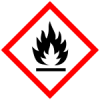The Producer has a plan to phase out Pesticides defined as…
Coalition status
Details
Toxicty
GHS safety labels
- H224

Extremely flammable liquid and vapour
Class: Flammable
Subclass: Liquids - H302

Harmful if swallowed
Class: Acute Toxicity
Subclass: Oral - H311

Toxic in contact with skin
Class: Acute Toxicity
Subclass: Dermal - H319

Causes serious eye irritation
Class: (Corrosion)Damage/irritation
Subclass: Eye - H331

Toxic if inhaled
Class: Acute Toxicity
Subclass: Inhalation - H335

May cause respiratory irritation
Class: STOT-respiratory irritation
Subclass: Single exposure - H340

May cause genetic defects (state route of exposure if it is conclusively proven that no other routes of exposure cause the hazard)
Class: Germ Cell Mutagenicity - H350

May cause cancer (state route of exposure if it is conclusively proven that no other routes of exposure cause the hazard)
Class: Carcinogenicity
